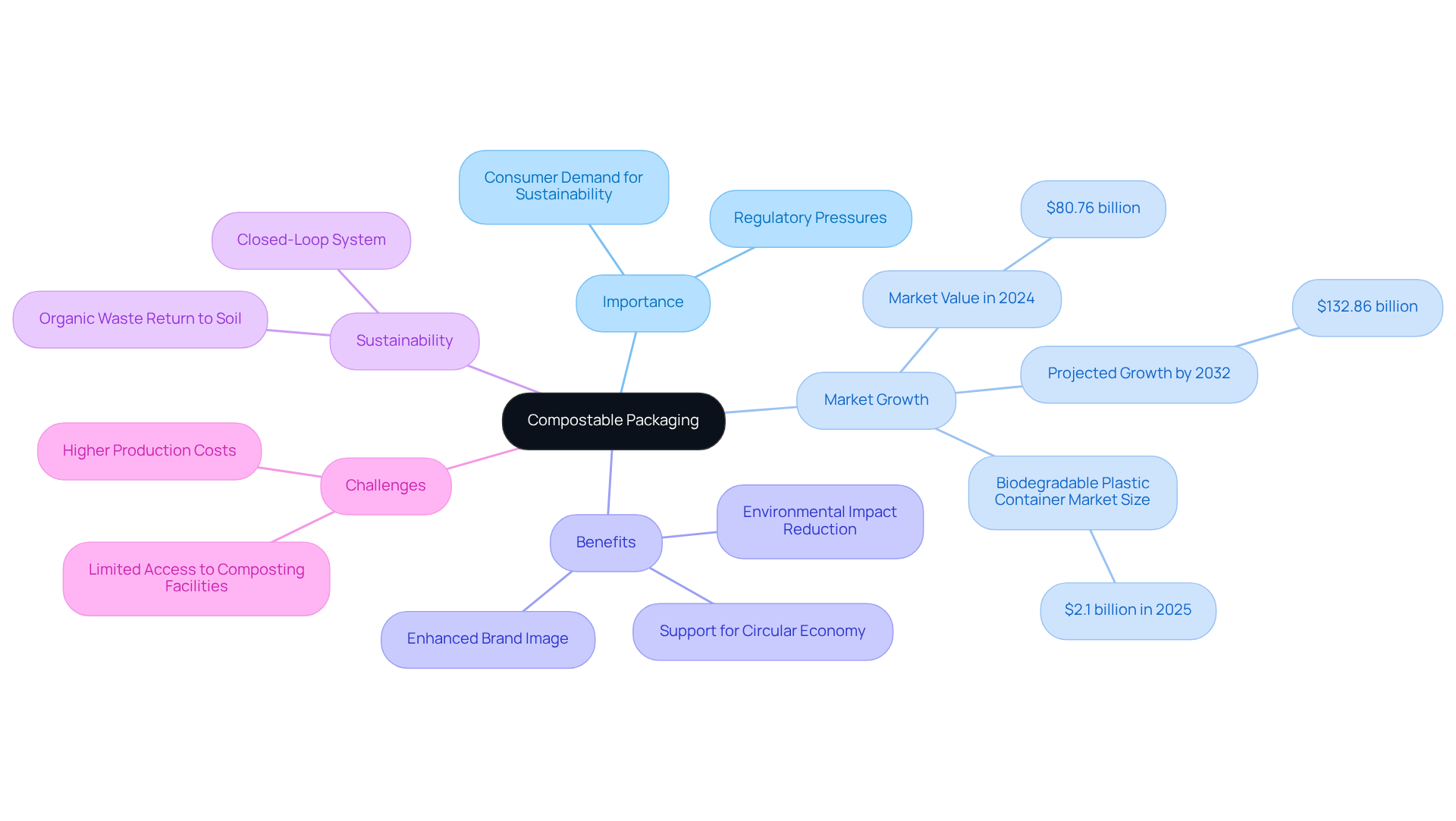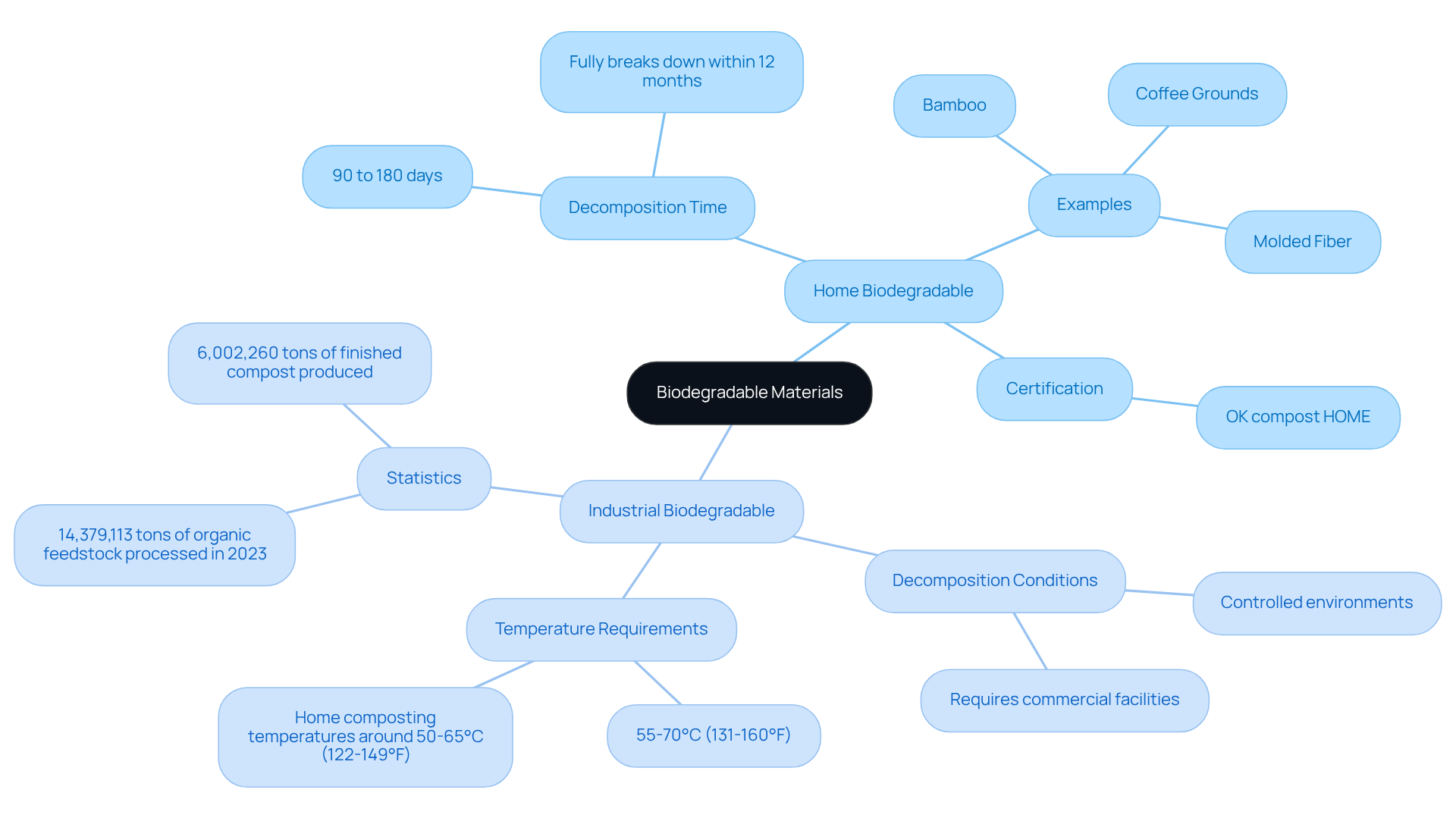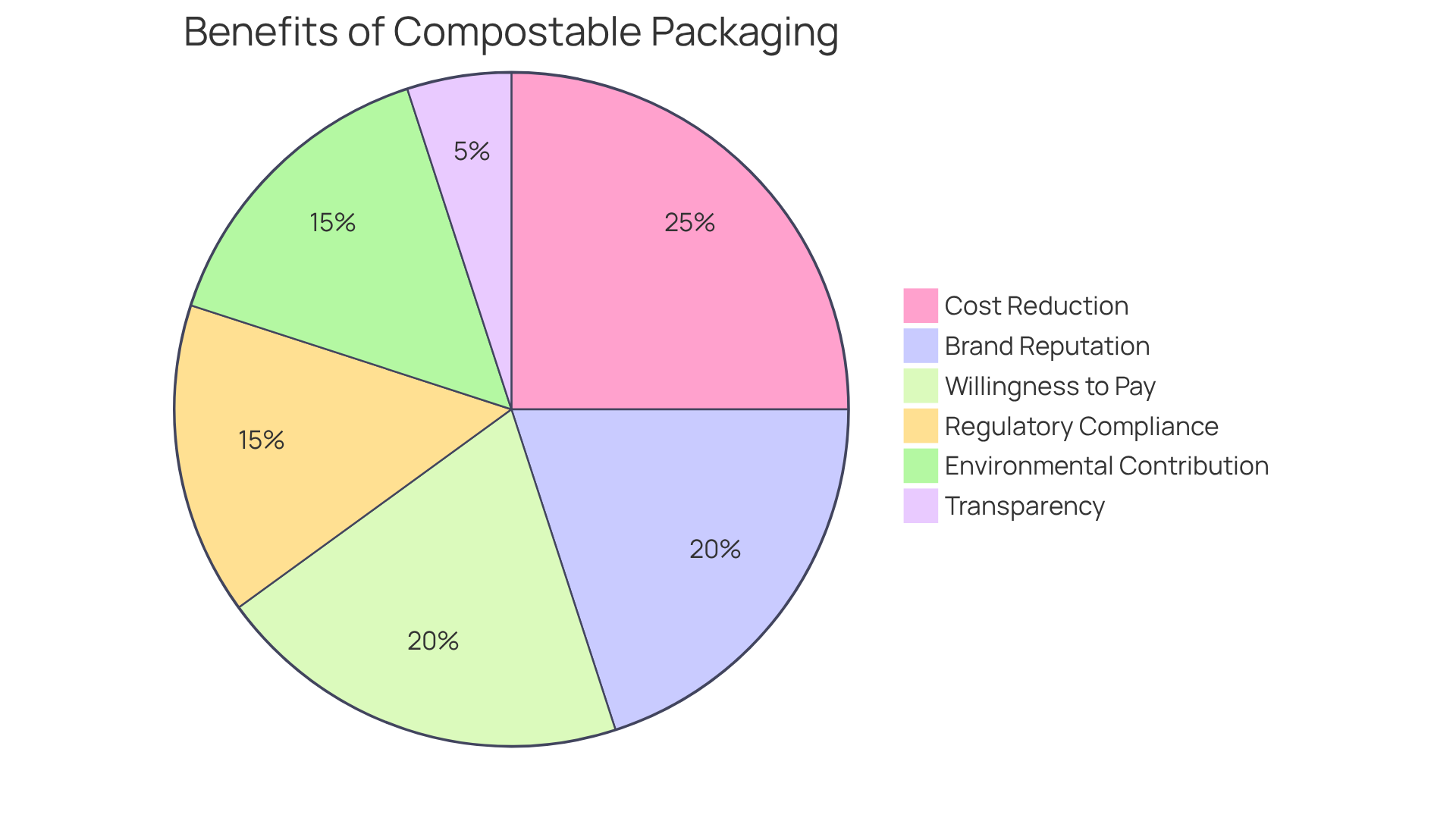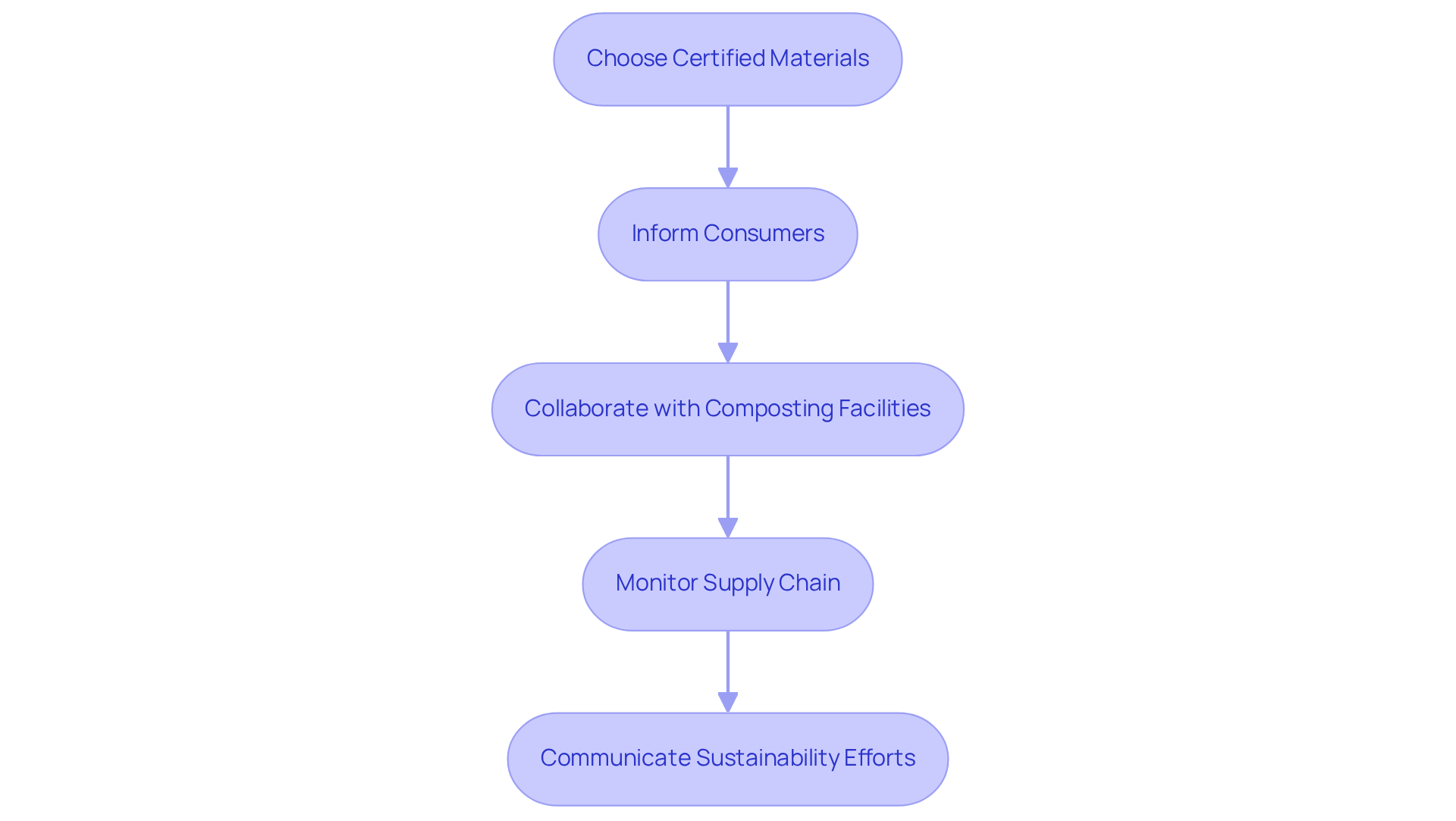Overview
The article examines the crucial compostable packaging solutions tailored for the nutraceutical industry, underscoring their vital role in advancing sustainability and satisfying consumer demand. It articulates that the adoption of these solutions not only mitigates environmental impact and reduces waste management costs but also bolsters brand reputation and ensures compliance with regulatory standards. This, in turn, cultivates consumer loyalty and stimulates market growth.
Introduction
The rise of eco-conscious consumerism is fundamentally reshaping industries, and the nutraceutical sector stands at the forefront of this transformation. As brands endeavor to meet the escalating demand for sustainable practices, compostable packaging emerges as a pivotal solution that not only mitigates environmental impact but also fortifies brand loyalty.
Nevertheless, the transition to these innovative materials presents significant challenges—how can companies effectively navigate the complexities of compostable packaging while ensuring compliance and consumer satisfaction? This question underscores the necessity for strategic approaches in adopting sustainable packaging solutions.
Define Compostable Packaging and Its Importance
Compostable materials encompass substances specifically engineered to decompose into natural elements within a composting environment, leaving no toxic residue. In sharp contrast to conventional plastics, which can remain in the environment for centuries, biodegradable materials typically decompose within a few months under ideal conditions. This type of container is especially crucial for the nutraceutical sector, as it aligns with the growing demand from consumers for sustainable products. By switching to compostable packaging solutions, companies can significantly lessen their environmental impact, assisting in waste reduction and promoting a circular economy. Moreover, this commitment to sustainability enhances brand image, appealing to eco-conscious consumers who prioritize environmentally friendly practices.
The global biodegradable container market, valued at approximately $80.76 billion in 2024, is anticipated to expand to $132.86 billion by 2032, highlighting the increasing significance of . Furthermore, the biodegradable plastic container material market size was USD 2.1 billion in 2025, emphasizing the growth potential of this sector. Effective implementations, such as Eastman's lightweight biodegradable tray that includes up to 43% recycled material certified by ISCC PLUS, illustrate how innovative containers can fulfill both ecological objectives and consumer expectations.
As the nutraceutical industry continues to advance, embracing compostable packaging solutions not only responds to regulatory demands but also positions brands as leaders in sustainability, ultimately fostering consumer loyalty and market expansion. Hasso von Pogrell, Managing Director of EUBP, underscores the importance of biodegradable plastic containers in achieving waste and climate goals, further reinforcing the relevance of this transition. However, it is critical to acknowledge potential challenges, such as limited access to organic waste processing facilities, which may hinder the widespread adoption of biodegradable solutions.

Differentiate Between Home and Industrial Compostable Packaging
Biodegradable materials are categorized into two primary types: home biodegradable and industrial biodegradable. Home biodegradable materials are designed to decompose within a backyard system, typically within 90 to 180 days under natural conditions. This type of wrapping is ideal for individuals engaged in home waste recycling who wish to manage their refuse in an environmentally friendly manner. According to the OK compost HOME certification, these materials must fully break down within 12 months in a home compost bin or pile, ensuring adherence to specific performance criteria. Examples of home biodegradable items include:
- Coffee grounds
- Bamboo
- Molded fiber
These items appeal to environmentally conscious consumers.
In contrast, industrial compostable materials require specific conditions found in commercial facilities, such as elevated temperatures and controlled environments, to decompose effectively. Commercial organic waste processing facilities maintain temperatures between 55-70°C (131-160°F), enabling materials to break down within weeks to a few months. Understanding these distinctions is crucial for companies to ensure that their containers, specifically , align with the disposal methods available to their clients, thereby enhancing ecological benefits. Recent statistics reveal that USCC member compost producers processed 14,379,113 tons of organic feedstock in 2023, underscoring the expanding infrastructure that supports sustainable waste management practices. As the composting sector evolves, an increasing number of companies are adopting compostable packaging solutions as home biodegradable options, contributing to a circular economy and reducing organic waste.

Highlight Benefits of Compostable Packaging for Businesses
Embracing biodegradable materials presents substantial advantages for companies in the nutraceutical industry. Firstly, this approach can lead to significant reductions in waste management expenses, as biodegradable materials are typically discarded with organic waste, thereby decreasing landfill charges. Additionally, utilizing biodegradable wrappers enhances brand reputation and fosters customer loyalty; notably, 74% of shoppers are willing to pay more for sustainable alternatives, reflecting a growing preference for labels that prioritize environmental responsibility. This alignment with consumer values is further underscored by the statistic that 63% of purchasers are more inclined to buy products from brands that have publicly declared sustainability goals.
Moreover, the use of compostable packaging solutions helps businesses comply with increasingly stringent regulations regarding plastic use, such as the UK’s objective to ensure all plastic products are reusable, recyclable, or compostable by 2025, positioning them as leaders in sustainability within their sector. By reducing dependence on fossil fuels and minimizing plastic waste, companies contribute to a healthier planet—a message that resonates strongly with environmentally conscious consumers. Furthermore, with 59% of consumers actively seeking information on receptacle recyclability, transparency in sustainability claims becomes crucial. This comprehensive approach not only but also solidifies a company's reputation as a responsible market leader.

Implement Best Practices for Compostable Packaging Solutions
To successfully implement biodegradable wrapping solutions, businesses must adhere to the following best practices:
- Choose Certified Materials: It is imperative to ensure that the biodegradable wrapping materials are certified by recognized organizations, thereby guaranteeing their biodegradability.
- Inform Consumers: Provide clear guidelines on the proper disposal of these materials, specifying whether they are suitable for home decomposition or require industrial processing.
- Collaborate with Composting Facilities: Forge partnerships with local composting facilities to facilitate the correct processing of these materials.
- Monitor Supply Chain: Conduct a thorough assessment of the entire to pinpoint opportunities for integrating biodegradable materials without compromising product integrity.
- Communicate Sustainability Efforts: Leverage marketing channels to articulate the transition to biodegradable materials, highlighting the ecological advantages to resonate with environmentally conscious consumers.
By implementing these practices, businesses can effectively transition to compostable packaging, thereby enhancing their sustainability profile and meeting the growing consumer demand.

Conclusion
Embracing compostable packaging solutions is not merely a trend; it is a vital step towards sustainability, particularly within the nutraceutical sector. By opting for biodegradable materials, companies can significantly reduce their environmental footprint while catering to the rising consumer demand for eco-friendly products. This strategic shift enhances brand reputation and positions businesses as leaders in sustainability, fostering consumer loyalty and trust.
Key insights from the discussion reveal the importance of understanding the differences between home and industrial compostable packaging, as well as the substantial benefits these materials offer to businesses. From cost savings in waste management to compliance with stringent regulations, the advantages are clear. Furthermore, adopting best practices—such as choosing certified materials and informing consumers—facilitates a successful transition to compostable packaging, ultimately contributing to a circular economy.
The significance of this shift cannot be overstated. As consumers increasingly prioritize sustainability in their purchasing decisions, companies that lead the way in adopting compostable solutions will not only meet regulatory requirements but also capture the loyalty of a growing market segment. It is imperative for businesses to act now, embracing these innovative packaging solutions to create a healthier planet and a brighter future for all.
Frequently Asked Questions
What is compostable packaging?
Compostable packaging refers to materials specifically designed to decompose into natural elements in a composting environment, leaving no toxic residue.
How do compostable materials differ from conventional plastics?
Unlike conventional plastics that can take centuries to decompose, compostable materials typically break down within a few months under ideal conditions.
Why is compostable packaging important for the nutraceutical sector?
Compostable packaging is crucial for the nutraceutical sector as it meets the growing consumer demand for sustainable products, helping companies reduce their environmental impact and promote a circular economy.
What are the market trends for biodegradable containers?
The global biodegradable container market is valued at approximately $80.76 billion in 2024 and is expected to grow to $132.86 billion by 2032, indicating a rising significance of eco-friendly solutions.
What is an example of an innovative biodegradable packaging solution?
An example is Eastman's lightweight biodegradable tray, which includes up to 43% recycled material certified by ISCC PLUS, demonstrating how packaging can meet ecological objectives and consumer expectations.
How does adopting compostable packaging benefit brands?
By adopting compostable packaging, brands can enhance their image as sustainable leaders, appeal to eco-conscious consumers, foster loyalty, and potentially expand their market presence.
What challenges exist in the adoption of biodegradable packaging?
One significant challenge is the limited access to organic waste processing facilities, which may hinder the widespread adoption of biodegradable solutions.




